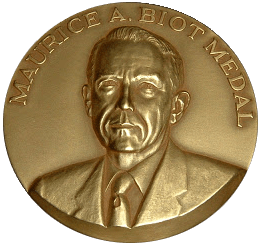Parallel Sessions (AM) Day 1 2 Hours
9:15 am – 11:15 am (CDT), UTC -5
Various talks held in parallel.
Session 1.1 Special Session Celebrating 70th Birthday of Prof. Rudnicki, Part 1
Chair Dmitry Garagash
422 My nearly career-long collaborations with John Rudnicki – James Rice, Harvard University
342 Effect of pore pressure oscillations on slip on a fault governed by rate and state friction – John Rudnicki, Northwestern University
366 Hydraulic fracture in weak rock – Emmanuel Detournay, University of Minnesota
423 Fracture mechanics of faults with rate-and-state friction – Dmitry Garagash, Dalhousie University
418 Impact of layering and mineral-fabric orientation on fracture surface roughness – Laura Pyrak-Nolte, Purdue University
421 Following in the footsteps of John Rudnicki: Simulation of sequence of induced earthquakes and aseismic slip due to injection into a hydrologically isolated rate and state fault – Ahmed Elbanna, University of Illinois Urbana-Champaign
Session 2.1 Interplay Between Creep, Relaxation, and Shrinkage
Chair Mija Hubler
180 Effect of selfdesiccation and autogenous shrinkage on tests of basic creep, drying creep and drying shrinkage – Abdullah Donmez, Istanbul Technical University
204 Optical measurement of unrestrained plastic shrinkage in 3D-printed concrete elements –Viacheslav Markin, Technische Universität Dresden
301 Improved multiphase modeling of the hygro-mechanical coupling for shrinkage and creep of concrete – Andreas Brugger, University of Innsbruck
166 Estimation of the stress in fully restrained alkali-activated concrete – Zhenming Li, Delft University of Technology
170 Tensile creep and stress relaxation of thermal and shrinkage stress in low heat performance concrete (LHPC) – Matthew D’Ambrosia, MJ2 Consulting
292 Shrinkage and swelling of hardened cement paste containing high amounts of limestone powder during water ad- and desorption – Christian Herget, Technische Universität Darmstadt
Session 3.1 Shrinkage and Sustained Load Behavior
Chair Roman Wan-Wendner
246 Early cracking in restraint concrete members – Christopher Schmidt, Rheinisch-Westfälische Technische Hochschule Aachen
164 Characterize the evolution of the tensile constitutive behaviour of cracked UHPCs under prolonged aggressive exposure and sustained loads – Salam Alobaidi, Politechnico di Milano
190 Numerical modelling of the effect of creep on corrosion-induced cracking in reinforced concrete90 – Ismail Aldellaa, University of Glasgow
321 A stochastic damage model for creep-failure behavior of quasi-brittle materials – Qing Wang, Tongji University
361 Performance and reliability of concrete specimens under sustained loads – Roman Wan-Wendner, Ghent University
416 Modelling of the viscoelastic properties of concrete with high substitution rate of Portland cement by mineral additions since setting, Brice Delsaute, Université libre de Bruxelles
Session 4.1 Fracture and Damage, Part 1
Chair Roman Wan-Wendner
189 Combined effect of restrained shrinkage and applied loads in slabs: from experimental program to numerical simulation– Miguel Azenha, University of Minho
377 Poromechanical cohesive interface element for crack propagation in fluid saturated porous media – Richard Regueiro, University of Colorado Boulder
241 Crystallization-induced damage in rocks using quasi-simultaneous X-ray and neutron tomography – Victor Okumko, L’Université de Pau et des Pays de l’Adour
315 Chemically-assisted fracture in porous media: a phase-field fracture study – Pania Newell, The University of Utah
288 Rate effect in frictional contact on porous rocks – Yaneng Zhou, Louisiana State University
249 Computational modeling of reactive aggregate size range, distribution and content effects on concrete expansion and deterioration due to alkali-silica reaction – Lifu Yang, Northwestern Unversity
Session 5.1 Concrete and Cementitious Materials
Chair Matthieu Vandamme
260 The role of disjoining pressure on the desiccation shrinkage of cementitious materials – Syeda Rahman, University of Texas at Austin
339 Breakage mechanics for cemented granular materials in surface-reactive environments – Xianda Shen, Northwestern University
352 Time-dependent behaviour of composite slabs subjected to different surface drying conditions: an experimental study – Gianluca Ranzi, The University of Sydney
387 Basic creep of cement paste at early age hydration and aging – Mateusz Wyrzykowski, Swiss Federal Laboratories for Materials Science and Technology
420 Investigation on the influence of the spring-loaded creep frame in deducing the concrete creep compliance function – Najeeb Shariff, National Institute of Technology, Warangal
197 Experimental study of water vapour condensation in cracked concrete with different specimen states visualised by fast neutron radiography – Ritesh Gupta, Université Grenoble Alpes
Session 6.1 Poromechanics and Biot Theory
Chair Christian Helmich
242 Discretizing pore structure at the steel-concrete interface for transport modeling – Thilo Schmid, Eidgenössische Technische Hochschule Zürich
243 Water uptake/release by hydrates as source of hygrothermic coefficients and thermal expansion of cement paste – Bernhard Pichler, Technische Universität Wien
293 Morphometric characterization of geomaterials’ strength – Alexandre Guevel, Duke University
310 Biot coefficients for low permeability rocks – Patrick Selvadurai, McGill University
345 Effects of porosity structure on the moisture-mechanical damage responses of a viscoelastic multiphase medium – Aimane Najmeddine, Virginia Polytechnic Institute
337 A reactive-chemo-mechanical model for subcritical cracking in acidized carbonate rocks – ManMan Hu, The University of Hong Kong
Session 7.1 Dynamic Measurement and Identificaiton
Chair Brock Hedegaard
232 Detecting shear wave arrival in highly porous chalk – Ermis Proestakis, Technical University of Denmark
329 Insights on ultrasonic dispersion in concrete – Eric Landis, University of Maine
362 Towards using geotechnical in-situ point measurements for the improvement of acoustic seabed surveying methods – Nina Stark, Virginia Tech
371 Identification of ultrasonic waves in multiphase frozen soils using the theory of poroelastodynamics – Hongwei Liu, University of Manitoba
409 Multi-target prediction of concrete engineering properties based on a single deep learning model – Yu Song, University of California, Los Angeles

